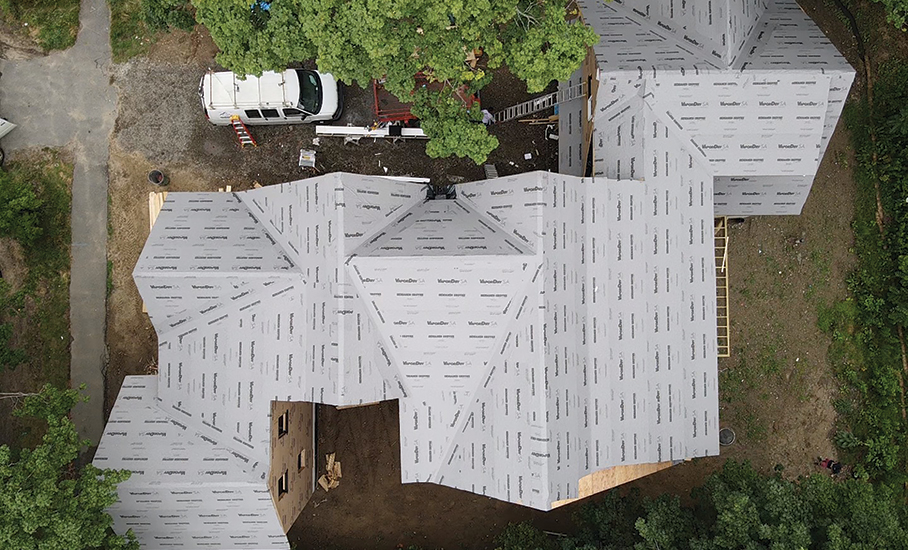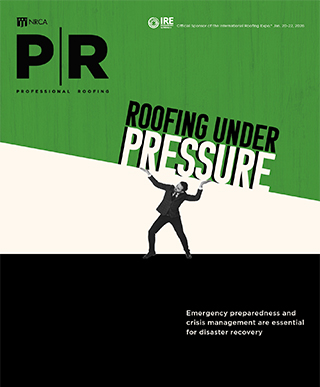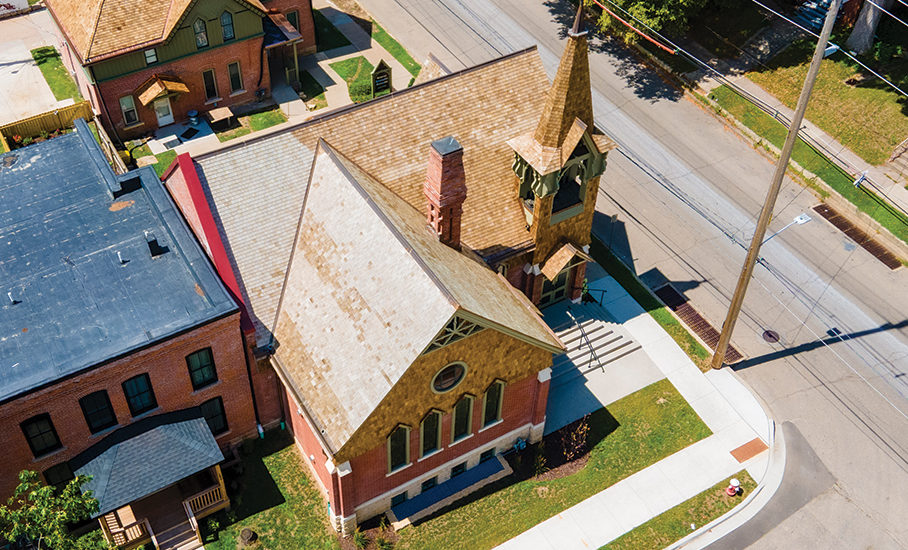
From the walls to the roof, moisture is the enemy of a building envelope. Understanding how moisture moves—and how to manage that movement—is important to designing and installing roof systems that are durable, long-lasting, and protect the occupants and contents within.
As houses become more energy-efficient, the changes in design may unintendedly affect roof systems. For example, conditioned attics are an increasingly popular option to increase energy efficiency. Unfortunately, they often are not designed with proper vapor permeability nor adequate ventilation in mind, which can lead to long-term roof problems.
Digging into the science of how moisture and moisture vapor move is a helpful first step to designing and building roof systems that best manage that challenge.
How does moisture move?
Although it is a common belief that shingles, coupled with an underlayment, form an impenetrable barrier against moisture reaching the roof deck, it is important to assume that moisture may get where you don’t want it to. There are two scenarios in which water or vapor can infiltrate a roof deck:
- From the exterior: Water typically finds its way to roof decks through a compromised underlayment, a common vulnerability in roof systems. But that’s not the only way. Mechanically attached roof underlayments, despite their utility, introduce potential pitfalls such as nail holes and a discontinuous layer that trapped moisture can seep through, leading to saturation of the sheathing. Once sheathing is damp, conventional impermeable underlayments hinder the drying process, resulting in structural degradation over time.
- From the interior: Interior moisture is a byproduct of routine activities such as talking, showering and cooking, as well as the presence of indoor plants. As warm air rises, it carries moisture vapor with it. This moisture can build up and become trapped in the sheathing layer by a nonpermeable underlayment.
Why is this important?
Understanding the vapor profile of a roof or wall assembly is important as the industry continues to see an increase in designing for air tightness and thermal resistance. In the past, houses had less insulation and poor air barriers, which allowed heat and water vapor to move through assemblies. Roof ventilation alone was once thought to be enough to remove excess moisture from attic spaces.
However, builders are increasingly moving to conditioned, well-sealed attic spaces with mechanical systems in the attic to create consistent environments. A side effect of this trend is an accumulation of interior water vapor as warm air moves toward the roof peak. With vapor-closed underlayments, water vapor cannot escape, leading to high moisture content in roof sheathing that can contribute to rot and failure, reducing a roof assembly’s life span.

What is vapor diffusion?
Vapor diffusion is the net movement of vapor molecules from an area of higher concentration to an area of lower concentration or from a warm area to a cooler area. Vapor diffusion is the environmental force that affects roof systems from inside.
Vapor diffusion does not require an air pressure difference to move moisture through a wall or roof assembly; it only requires a difference in vapor pressure or temperature between the inside and the outside of the structure. Joseph Lstiburek explains this concept in “Insulations, sheathings and vapor retarders,” which was published in Builder’s Guide for Cold Climates. Lstiburek, principal of Building Science Corp., Westford, Mass., says during a hot, humid summer, the exterior of a house has high vapor pressure and high temperature while the interior is often air-conditioned so it is cooler and has lower vapor pressure. In this scenario, water vapor moves from the exterior (high pressure/high temperature) to the interior (low pressure, low temperature).
The reverse occurs in the winter when vapor drives from the warm interior to the cold exterior.
Although moisture vapor may not be as big of a problem as rain or other water entering the envelope, it is something that should be addressed throughout the design and build process. When water vapor passes through an assembly and encounters a surface that has a temperature below the dew point (the temperature at which water vapor condenses), it becomes liquid. This can lead to wood sheathing rotting, molding and decaying.
Again, unventilated attics are one potential problem area. When warm, humid air rises into an attic, a vapor-closed roof membrane, such as a self-adhering ice and water barrier, synthetic underlayment or closed-cell spray polyurethane foam insulation, can trap moisture, which can lead to condensation, mold and premature roof failure.
Designers and contractors should consider adjusting their long-standing practices to accommodate these types of design changes. For un-ventilated attics, for example, roofs need vapor permeance much like walls, so a vapor-permeable roof covering becomes essential.
Designers and installers could:
- Use a ventilated roof system (ventilated space directly under the roofing material) for a conditioned attic to reduce condensation risk
- Use a self-adhering, vapor-permeable roof underlayment for vented and unvented roof assemblies
- For best practice, use ventilation and a vapor-permeable underlayment (for example, a ventilation mat plus a self-adhering, vapor-permeable membrane)
Hot versus cold roofs
Cold and hot roofs can be categorized as vented versus unvented roof assemblies. Knowing which is which will help ensure the right products are specified to allow a roof system to perform properly.
Cold roof assemblies include ventilation, often through ridge vents and soffits, and allow air to flow beneath the roof sheathing. A cold roof draws cool, dry air through the eaves and pushes hot, moist air up and out the ridge vent.
This airflow helps roof sheathing stay cold and dry compared with the hot, humid interior space, which can prevent issues such as moisture buildup and condensation. Insulation typically is installed between the ceiling joists that form the floor of the attic, creating a barrier between the interior space and attic.
In contrast, hot roof assemblies forego ventilation in favor of increased insulation directly against the roof deck in the attic. Hot roof assemblies have grown in popularity because of their easy air-sealing capabilities and the demand for more energy-efficient and net-zero homes.
This design maximizes energy efficiency by minimizing heat transfer between the interior and exterior environments. Spray polyurethane foam or other high-performance insulation materials often are used in hot roof assemblies, allowing for superior thermal performance and air tightness. However, the absence of ventilation raises concerns about moisture management and potential condensation issues, especially with conditioned attics.
How to manage vapor
Materials that comprise a building envelope each manage vapor differently. Those that are vapor-permeable let vapor pass through and dry out. Those considered vapor retarders or barriers slow or stop vapor movement.
But there is a difference between a vapor barrier and vapor retarder. And specifying the wrong one can lead to moisture issues.
A vapor barrier blocks vapor diffusion movement, and a vapor retarder regulates moisture in a gas state by limiting water vapor movement. A vapor retarder can help prevent water vapor from moving into building assemblies where it can condense into liquid water within the structure.
Vapor retarders come in a range of permeance levels, as follows:
- Class I vapor retarders (0.1 perms or less) include sheet metal, glass, polyethylene sheets and rubber membranes.
- Class II vapor retarders (more than 0.1 perms and equal to or less than 1.0 perms) can be extruded polystyrene or unfaced expanded polystyrene, 30-pound asphalt-coated paper, bitumen-coated kraft paper and plywood.
- Class III vapor retarders (more than 1.0 perms and equal to or less than 10 perms) consist of concrete block, gypsum board, board lumber, brick or 15-pound asphalt coated paper.
Vapor retarders are one of the methods to meet code requirements for roof assemblies in cold climates. A vapor retarder should be installed on a building’s interior.
How to incorporate vapor permeability
Protecting a roof system from the effects of trapped water vapor requires professionals to install each component with other components in mind.
Green Building Advisor, an online resource for building professionals, recommends examining a structure’s vapor profile in four steps:
- Determine the vapor permeability of each component in the assembly
- Identify the least vapor permeable component(s)
- Assess the extent and direction of the vapor drive
- Assess the moisture storage capacity and drying potential of the assembly
Green Building Advisor notes this method is not exact. More definitive answers may be found by consulting a building scientist or using a quantitative analysis tool (such as WUFI computer modeling software).
How to choose the right underlayment
When weighing the pros and cons of each type of roof underlayment, you’ll want to consider a number of factors:
- Roofing material type: What underlayment does the roofing material manufacturer recommend? Ensure you follow manufacturer requirements or you could risk voiding the warranty.
- Cost: Cost is always going to be a consideration. But it’s important to not let budget completely dictate a decision. Ensure homeowners understand the importance of building a quality, high-performance roof system. The roof is the first line of defense for the house, so it’s worth making a larger investment even if it means sacrificing an interior design feature.
- Climate: Not all roof systems require all the bells and whistles if you don’t need them. In much of Arizona, for example, moisture may not be as big of a concern, and asphalt-based underlayment might be a suitable choice. But in Florida, which is plagued by wind and rain, designers should assume rain may get in under the shingles; therefore, a more robust underlayment, such as a self-adhering vapor-permeable roofing membrane, might be worth the investment.
- Attic: If a home’s attic is conditioned, moisture from the rising heat within will need a way to escape. A vapor-permeable underlayment will help the moisture exit the roof system, helping it dry out and protecting the wood from rot.
- Installation trade-offs: Asphalt-based underlayment is a go-to choice because it meets code and is less expensive. But it’s also prone to tearing and wrinkling. The extra steps to fix these issues may not be worth the lower price.
- Air control: If a roof deck is part of the air-control strategy, a self-adhering underlayment will self-seal around all fasteners.
- Roof exposure: Most asphalt-based underlayment needs to be covered immediately with the roof covering material. Other underlayment options may extend the exposure allowances for more complex designs.
Choosing a proper underlayment is an important consideration for managing vapor, and a product’s vapor permeability must be considered along with its other features and benefits.
Vapor-permeable underlayments include roofing felt and self-adhering acrylic underlayment (acrylic adhesives are designed to be vapor permeable, and common adhesives such as asphalt or butyl are commonly vapor closed).
Impermeable materials include synthetic roof underlayments (mechanically attached, laminated polypropylene or polyethylene plastic materials) and self-adhering asphalt roof underlayments. Self-adhering asphalt roof underlayments are developed to protect vulnerable areas on a roof from ice and water damage and may not be appropriate for covering an entire roof.
For wood and metal roofing materials, another essential component for managing moisture is creating adequate ventilation space of ¼ of an inch between the roofing material and underlayment to allow for drainage and drying. Condensation can occur on the underside of these roofing materials. When condensation combines with cold air, it could corrode or decay roofing materials. By designing a system with an airspace between the roof deck and roofing material, trapped moisture can dry out or more easily drain away.
There are several methods for creating an airspace. One is double-strapping. Much like traditional furring strips or battens in a wall system, double-strapping separates a roofing material from the sheathing to create an airspace. Roofing workers install the first layer of furring strips parallel to the rake to create vertical channels that will ensure proper airflow and moisture drainage. Then, they install the second layer parallel to the eave.
Another option is to install a roof ventilation mat, which adds an air gap between the roof deck and panels; when combined with a ridge vent, this helps create convective airflow to help dry out a space. A roof ventilation mat also levels out imperfections in a roof, so it can help address oil canning that sometimes occurs with standing-seam metal roofs.
Communicate and collaborate
The complexities of building construction are changing the way roofing professionals approach projects. When it comes to working on a roof and understanding complex details, it’s vital to communicate across crews ahead of time. Before arriving at a job site, it’s important to talk about the roof and wall details and look at the entire building envelope to evaluate how everything is designed to work together. Addressing potential modifications early in the process is more effective than making adjustments during installation. This approach ensures roofing workers receive proper education about the specifics and execute installations with precision.
This includes coordinating across different subcontractors to ensure proper installation sequencing to promote proper moisture drainage and drying. For example, who will install the finish fascia and ensure proper shingle overlapping occurs between the roof underlayment and the drip edge? When will roof system penetrations be added, and how will that affect flashing around those areas?
Implementing proactive measures should include preconstruction meetings with architects, installers, contractors, manufacturers and builders. Local training events from manufacturers and product representatives can teach installers and contractors proper techniques, providing hands-on experience along with the opportunity to ask questions in real time.
Above all, remember each product and design element works with and affects others. Understanding how moisture moves and how those elements respond is critical to managing water and water vapor for the life of the home.

KAYLEN HANDLY
Technical innovation manager
Benjamin Obdyke Inc.



